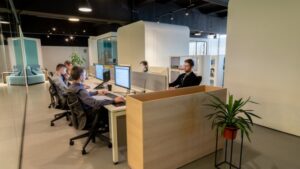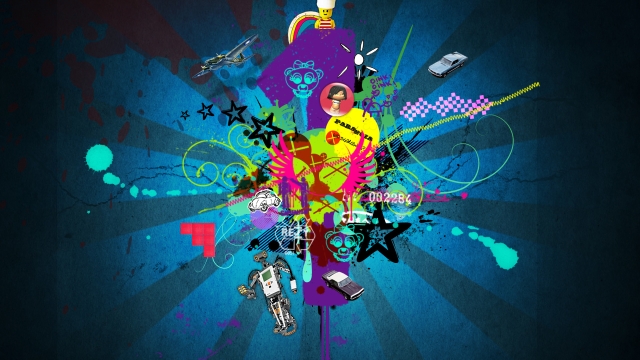In the ever-evolving world of technology, the boundaries between disciplines continue to blur, giving rise to new and exciting hybrid fields. One such fusion that has emerged in recent years is the merging of graphic design and software development. At first glance, these two fields may appear vastly different, with one focused on aesthetics and visual communication, and the other diving deep into the intricacies of programming and code. However, upon closer inspection, it becomes evident that the combination of these two domains has the potential to create powerful and visually stunning experiences.
Graphic design is the art of communication through visuals, where designers use colors, typography, and composition to convey a message or evoke certain emotions. On the other hand, software development involves the creation of computer programs and applications that power the digital world we live in. While traditionally seen as separate entities, the convergence of these disciplines opens up a world of possibilities for designers and developers alike.
When these two worlds collide, the result is a seamless integration of aesthetics and functionality. By combining the principles of graphic design with the technical prowess of software development, professionals can create user interfaces that not only look visually appealing but also provide a smooth and intuitive user experience. This fusion allows designers to go beyond static images and prototypes, enabling them to give life to their creations and see their designs interact in real-time.

In this article, we will explore the exciting realm of designing code, where graphic design and software development intersect. We will delve into the synergies between these fields and highlight how their harmonious collaboration can lead to the creation of truly exceptional digital experiences. Whether you are a graphic designer looking to expand your skill set or a software developer interested in incorporating visual design principles into your work, this guide will provide valuable insights and resources to help you navigate this exciting crossroads. So, let’s dive in and discover the boundless possibilities that arise when graphic design meets software development.
The Role of Graphic Design in Software Development
Graphic design plays a crucial role in the field of software development. It not only enhances the aesthetic appeal of a software application but also greatly influences its usability and user experience. Through the creative use of visual elements, graphic design helps to communicate information effectively and engage users in a more intuitive and engaging way.
One of the primary objectives of graphic design in software development is to create visually appealing interfaces that align with the brand identity and purpose of the application. This involves carefully selecting colors, typography, and imagery that reflect the desired tone and atmosphere. By creating an aesthetically pleasing environment, graphic design helps to establish a positive first impression and entice users to explore further.
Beyond aesthetics, graphic design also focuses on improving the usability of the software. Designers employ various techniques such as creating clear navigation pathways, organizing content logically, and prioritizing important information. These considerations help users easily navigate through the application, locate desired features, and accomplish tasks efficiently. Good graphic design ensures that the software interface is intuitive and user-friendly, ultimately enhancing the overall user experience.
In addition to the visual aspects, graphic design is closely interconnected with the development process itself. Designers collaborate with software developers to ensure that the design specifications are implementable and compatible with the technical constraints of the application. This collaboration promotes a seamless integration of design and functionality, resulting in a harmonious blend of visual appeal and technical excellence.
In conclusion, graphic design is an integral part of software development, contributing to both the aesthetics and usability of applications. By combining the principles of graphic design with the technical expertise of software development, designers and developers can create innovative and visually stunning software solutions that captivate users and deliver exceptional user experiences.
The Intersection of Visual Aesthetics and Functional Code
Designing code involves a fascinating fusion of graphic design and software development. It brings together the visual aesthetics of design with the logic and functionality of code, resulting in an exciting and dynamic process. This article explores the synergy between graphic design and software development, showcasing how these two disciplines intersect and complement each other.
The Power of Visual Communication
Graphic design plays a crucial role in code development, as it is the visual language that brings ideas to life. Through the use of colors, typography, and layout, designers create visually appealing interfaces that provide a seamless user experience. The power of visual communication in code design cannot be underestimated, as it not only enhances aesthetics but also aids in conveying information effectively.
Merging Creativity with Functionality
Software development, on the other hand, focuses on the functionality and performance of the code. It is the technical aspect that ensures the software operates smoothly and efficiently. By merging creativity with functionality, designers and developers work together to strike a balance between visual appeal and robust functionality. This collaboration results in visually stunning interfaces that also deliver a seamless user experience.
Design Systems and Development Frameworks
To facilitate the fusion of graphic design and software development, design systems and development frameworks have emerged as invaluable tools. Design systems establish visual guidelines and reusable components that allow for consistent and coherent design across various software products. Development frameworks provide a foundation for building code, streamlining the development process, and ensuring compatibility across different platforms.
In conclusion, the convergence of graphic design and software development offers a wealth of opportunities for creating visually stunning and highly functional code. By embracing the intersection of visual aesthetics and functional code, designers and developers can work together to craft compelling user experiences and push the boundaries of what is possible in the digital world.
Practical Tips for Designing Code with a Graphic Design Approach
Now that we have explored the fusion of graphic design and software development, let’s delve into some practical tips for designing code with a graphic design approach. By integrating the principles and techniques of graphic design into our coding process, we can create visually appealing and user-friendly software applications.
Consistency is key: Just as a graphic design project relies on consistent fonts, colors, and styles, maintaining consistency in your codebase is essential. Use standardized naming conventions, indentation styles, and file organization to make your code easily readable and understandable, not only for yourself but also for your fellow developers. Consistency promotes efficiency and collaboration within your coding team.
Whitespace for enhanced clarity: In graphic design, whitespace plays a crucial role in creating visual hierarchy and allowing elements to breathe. Similarly, incorporating whitespace in your code is vital for improving its readability. Use proper indentation, line breaks, and spacing to separate different sections and elements of your code. Well-structured and easily scannable code will help others navigate and modify your codebase with ease.
Visualize your code: Graphic designers often rely on visual aids such as wireframes, mock-ups, and storyboards to communicate their design ideas. Similarly, visualizing your code through diagrams, flowcharts, or UML diagrams can help you gain a high-level understanding of its structure and flow. Visualization tools like Graphviz or UML software provide valuable insights into complex codebases and can aid in identifying potential optimizations or design flaws.
Houston Website Design
Incorporating graphic design principles into software development can elevate the quality and aesthetics of your code. By prioritizing consistency, whitespace, and visualization, you can enhance the user experience and maintain an organized and visually pleasing codebase. Remember, designing code is not just about functionality, but also the seamless marriage of aesthetics and user experience.
















